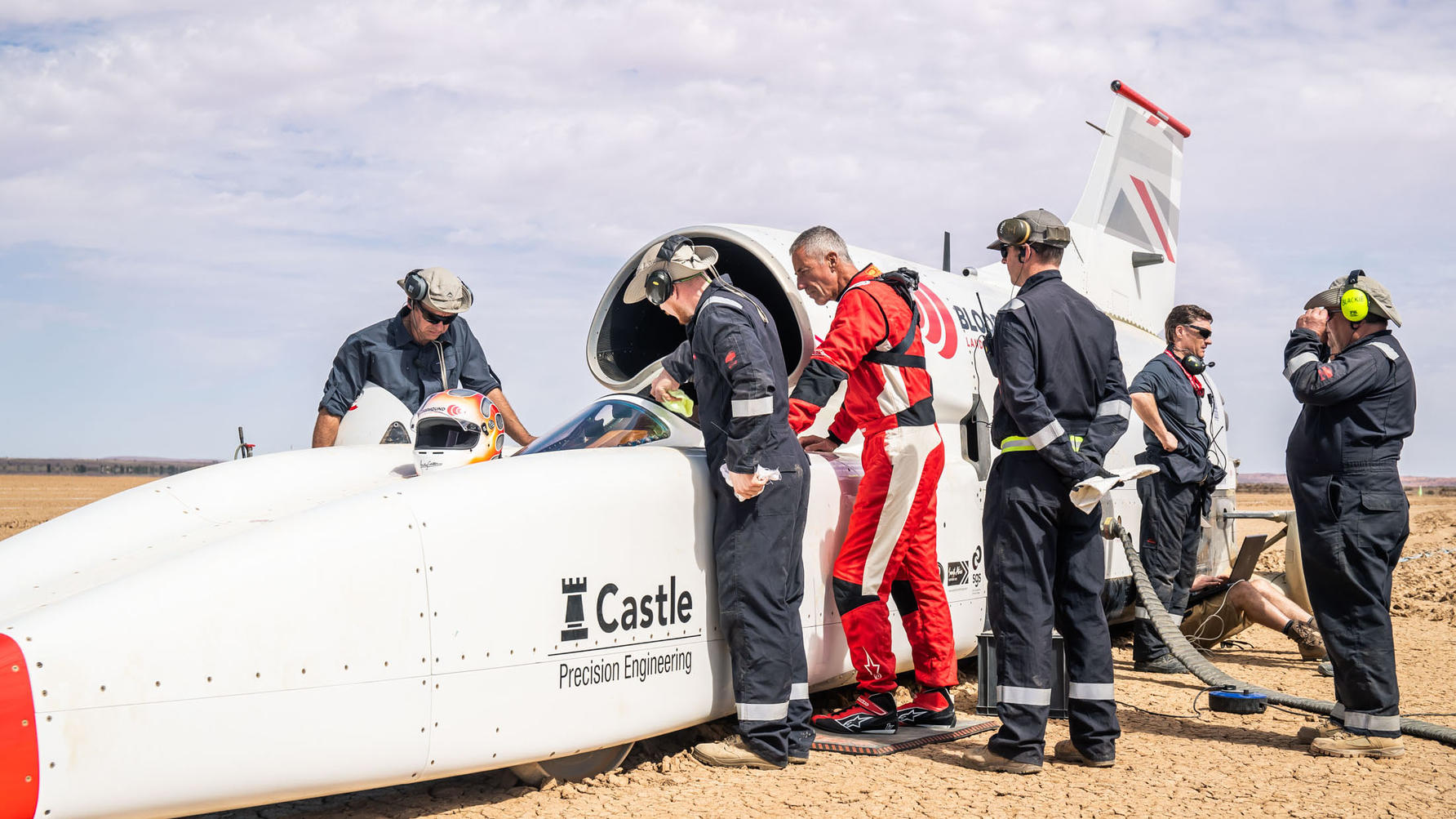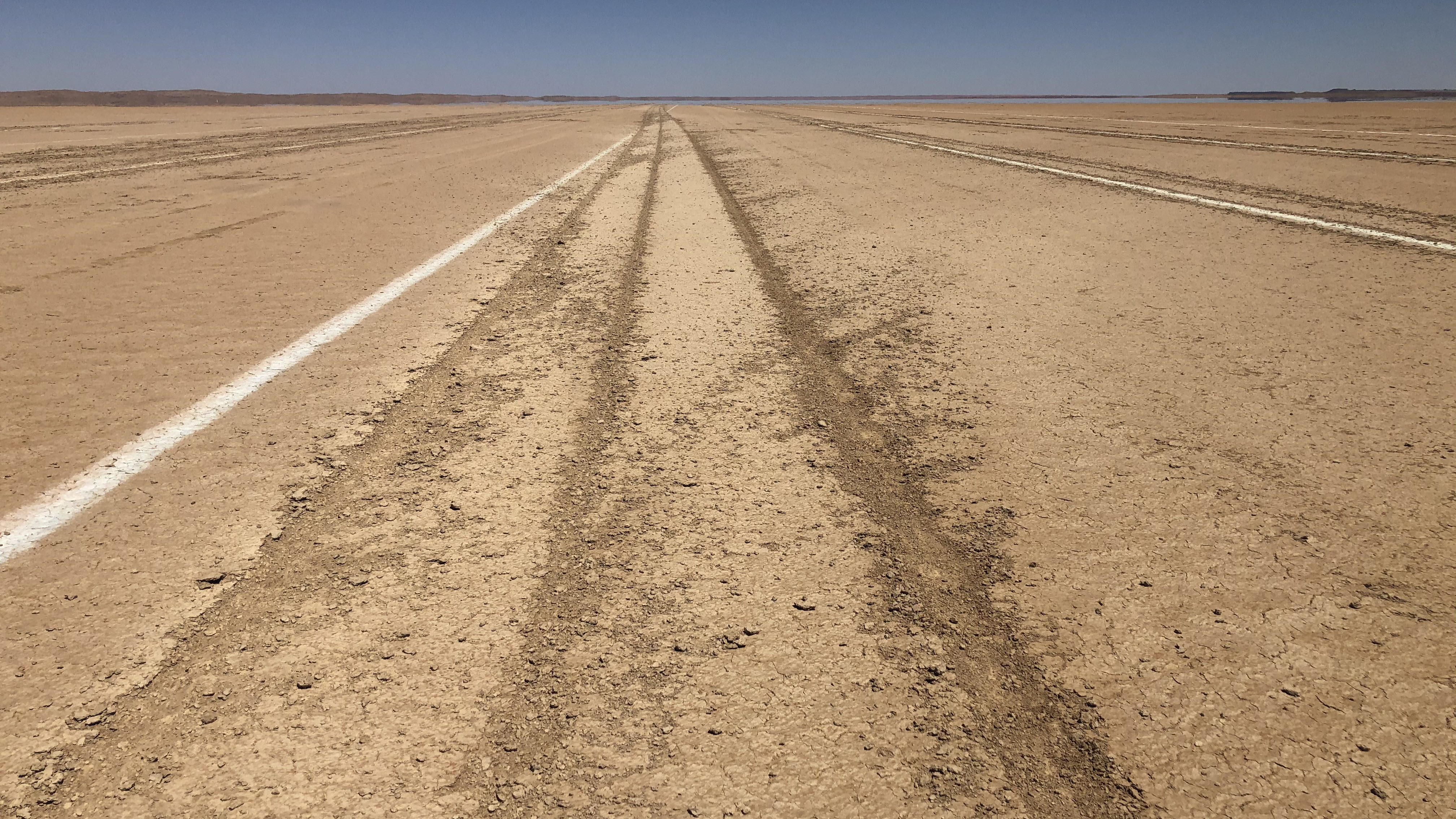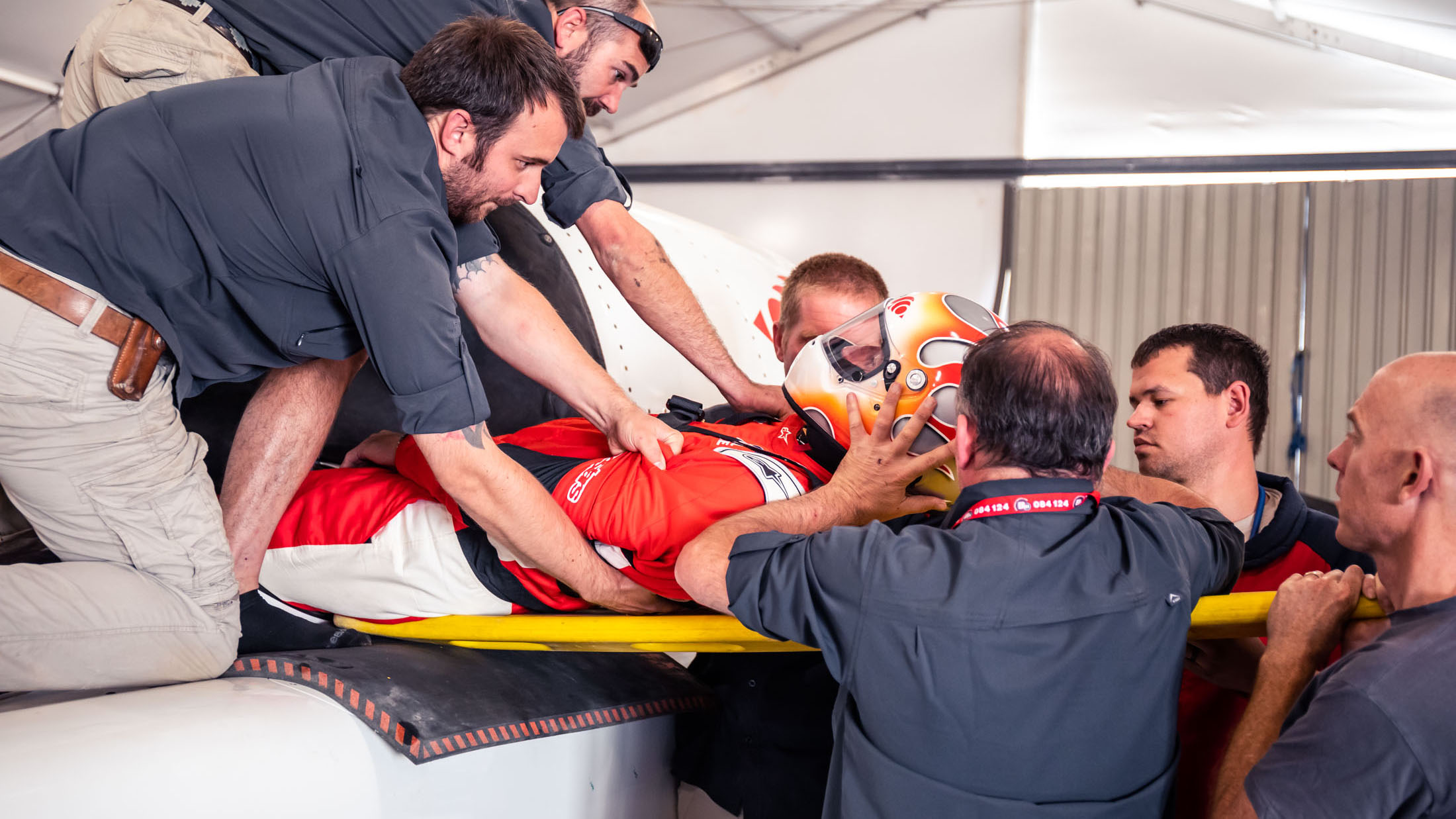
Andy Green on Bloodhound: 'it's worse to drive than I hoped'
Time to geek out on yaw, static roll margins and why Bloodhound is mostly going sideways
Bloodhound is a hive of activity. Sitting in a big white marquee on the eastern edge of Hakskeen Pan, the land speed record car is being dismantled. Earlier in the day, it had thrown up a fire warning at 481mph, causing the run to be aborted. It’s the second time the same sensor has caused this issue, so the team will spend the next few days tracking down and fixing it. While that was going on, Top Gear's Ollie Marriage cornered Andy Green for a catch up.
Ollie Marriage: I took a picture on the pan earlier and it took me a second to realise what I was looking at – the wheel tracks weren’t even. In fact in one of them Bloodhound is so far sideways the front and rear wheels on one side are in line and there’s only three tracks through the desert.
Andy Green: I know the one you’re talking about. That was at about 350mph. Probably 90 degrees of steering lock and four degrees of yaw.
OM: I can’t even begin to compute… put it this way: has Bloodhound been as good to drive as you hoped?
AG: No, it's actually been worse. But that's nothing to do with the car. It's actually to do with the lateral wheel grip on the desert. I was fairly confident we'd be able to expand the crosswind limit to 15mph and Bloodhound would cope. And it can’t. At low speeds it’s like driving from snow onto ice – we were expecting that would happen at around 300, 350, 400mph but then at 500-600mph the aero load would build back up.
But at about 200mph, if there’s a crosswind the car starts moving around, and by 300 it’s moving around even more. It’s really obvious. It's happening earlier than we expected, it's more obvious than we expected, and mechanical grip is lower than we expected. Now, that makes it slightly more challenging to drive. It reduces our crosswind limit. So we’ll just lower the limit and I’ll learn how to cope.
The plus side of having limited lateral grip is that if the car does get into a slide, it will slide. it won't dig in. So we’ve got friction with the desert generating grip and we’ve got the grip of turning the wheels and displacing material and pushing the car sideways – that grip appears to be lower than we expected. Not dramatically, but a little bit. We knew it was going to be low, in fact possibly it is what we were expecting, it’s just the feel of it isn’t what I was expecting.
OM: So the front wheels, at what point is their interaction with the air more important than it is with the ground?
AG: I don't know. And even if we'd been up to 600 miles an hour and felt that interaction, I'm not sure we could say there was a specific point. If we could guarantee to run in identical crosswinds day after day after day and measure at different speeds, you might be able to actually take an estimate of that, but we can't. So we’ll build up a database: at low speed it's all mechanical grip. At intermediate speeds the car is very light, it's getting less grip. And at high speeds it's getting more aerodynamic grip. But it's subjective as much as anything else.
We've got an inertial monitoring unit, a gyro unit to look at yaw rates and steering responses. At the end of this project we might have enough data to construct a dynamic model of how the car behaves. At the end, not the beginning. We've got to do all the running first to have enough data to do that. Which is the interesting bit. This is proper out-there research and there's nobody we can speak to about how the car’s going to handle. I’ll need to get in and find out. I find that fascinating. Which is why I go out on to the desert after every run and look at all the tracks to find out exactly what’s happening.
Top Gear
Newsletter
Thank you for subscribing to our newsletter. Look out for your regular round-up of news, reviews and offers in your inbox.
Get all the latest news, reviews and exclusives, direct to your inbox.
You've obviously watched some of the cockpit video and seen what I’m doing with the steering?
OM: Busy.

AG: It's surprising me that I'm doing that much. I'm looking so hard at what the car is doing, the picture I have in my mind from the previous two or three days of cockpit video and then doing what looks right at the time with the steering. And then I come back in afterwards and analyse - was that better or worse than yesterday? And pretty much every day it’s better. We’ve only run the car nine times, conditions are different each time. So we're still building up not only the database in terms of the noughts and ones in here [taps laptop], but the database of how I respond up in here [taps head]. That's the really interesting bit.
OM: The dynamics of it. Does it feel more like an airplane than a car?
AG: Combination of the two. The really uncomfortable bit was first time we took it out. It was a 10mph - gusting to 15mph - crosswind, exactly the right thing to do and at relatively low speed, 200-300mph, not 500mph plus. The car was not only yawing, it was rolling and roll is something you absolutely never want to feel in an LSR car.
It wasn’t much – 1-2 degrees – but with that great sail on the back the gusts of wind were rolling us a bit. OK, I got used to it, that’s what it feels like in a gusting crosswind. Now, what I don't need to do is try to correct it – firstly because trying to steer back on line is the wrong direction, and more steering input would increase the roll because you’ve then got the chance of a roll/yaw coupling, and the extra pressure making that front wheel dig in.
You want to minimise the yaw rates and control the yaw first and then control the lateral displacement. In that order. So quickly control the yaw rate, slowly control the displacement. Having felt that initially, and then another 2-3 times I could go “OK, that’s the baseline, I understand that, I need now to minimise that and make sure I don't aggravate it”. But the first couple of times it was a horrible feeling. Horrible.
To a certain extent I've been spoiled – Thrust SSC had a 3.5m track at the front. It didn’t have any roll, it was too wide [Bloodhound’s front track is 1.1m]. Anyway, I needed over the first few runs to understand what the roll felt like and what was/wasn’t acceptable. We’ve since tried it in a gusting 10-12 and the car moved sideways and then corrected. And even if it moves offline 4, 5, 6, 8 metres, I’ve got a 300m safety zone. If it moves off line 100 metres the car will still be safe.
But nonetheless if you don't understand what is the aerodynamic centre in yaw, and what is the yaw static margin, you need to have a hard think about whether you should be designing a high speed car.
OM: I’m glad I’m not…
AG: Think about the simple schoolboy way of doing it. Take a picture of the side of your car, cut it out and paste it on a piece of cardboard. That's basically what the wind sees sideways on. Measure where the centre of gravity is, the load on the front and rear wheels, mark that on the car and then balance your piece of cardboard. And if you're balancing it behind where the central gravity is then that's a good thing. If you're balancing it in front, it really isn't.
We need to be able to showcase how great science and engineering is and making a complete arse of it, not understanding the science. Frankly, we'd be letting down a whole generation of kids who are supposed to be getting excited about how cool science is. We need to get this right.
90 per cent of our problem relates to almost nothing that's gone before
OM: It still sounds very complex.
AG: It’s actually more complex than you can sensibly model, which is why yaw static margin and yaw stability is such a complex thing with aeroplane design. And why they still do a lot of testing in wind tunnels. And why test pilots are such an important part of flying new aircraft.
Take Formula One. Essentially unlimited budgets, huge amounts of experience, same track as last year, same tyres as last year: can they just design a car that will be perfect first time? No. There’s a tonne of design refinement after they put it on the track for the first time.
So take a surface you've never run on, with wheels you've never run on, with aerodynamics you don’t understand, on a surface you don't understand. Are you going to get that right first time? Not a chance. The fact we’ve got this close at a single attempt is hugely impressive.
OM: Is there any overlap with other motorsport?
AG: We can take little bits, but 90 per cent of our problem relates to almost nothing that's gone before. Which is why I say, from a mathematician's point of view, blank sheet of paper approach, the “I wonder how we can solve this problem” processes, I find fascinating. And from the fighter pilot point of view, “I wonder how we're going to actually build, monitor and control this car, and set up the environment of a 12 mile long air base, 5,000 miles from home”, well, that’s fascinating too.
I’ve been to obscure places in the world and run combat operations from relatively barren, austere places. But actually doing it with Bloodhound… there’s completely nothing out here. And setting up a safe operating environment and what is basically a ‘sterile’ runway that is so long there's no place we can see all of it… it’s very impressive.
OM: How the hell do you compute what’s going on?
AG: I'm lucky enough to have driven a jet car supersonic and spent a whole career driving jet fighters and having the ability to absorb stuff outside of your immediate environment. It's what makes a good jet fighter pilot.
Trending this week
- Car Review
BMW iX3










